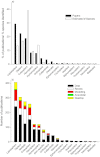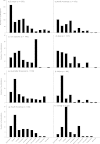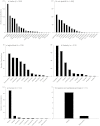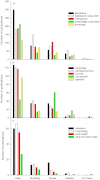Assessing insect responses to climate change: What are we testing for? Where should we be heading?
- PMID: 23638345
- PMCID: PMC3628384
- DOI: 10.7717/peerj.11
Assessing insect responses to climate change: What are we testing for? Where should we be heading?
Abstract
To understand how researchers are tackling globally important issues, it is crucial to identify whether current research is comprehensive enough to make substantive predictions about general responses. We examined how research on climate change affecting insects is being assessed, what factors are being tested and the localities of studies, from 1703 papers published between 1985 and August 2012. Most published research (64%) is generated from Europe and North America and being dedicated to core data analysis, with 29% of the studies analysed dedicated to Lepidoptera and 22% Diptera: which are well above their contribution to the currently identified insect species richness (estimated at 13% and 17% respectively). Research publications on Coleoptera fall well short of their proportional contribution (19% of publications but 39% of insect species identified), and to a lesser extent so do Hemiptera, and Hymenoptera. Species specific responses to changes in temperature by assessing distribution/range shifts or changes in abundance were the most commonly used methods of assessing the impact of climate change on insects. Research on insects and climate change to date is dominated by manuscripts assessing butterflies in Europe, insects of economic and/or environmental concern in forestry, agriculture, and model organisms. The research on understanding how insects will respond to a rapidly changing climate is still in its infancy, but the current trends of publications give a good basis for how we are attempting to assess insect responses. In particular, there is a crucial need for broader studies of ecological, behavioural, physiological and life history responses to be addressed across a greater range of geographic locations, particularly Asia, Africa and Australasia, and in areas of high human population growth and habitat modification. It is still too early in our understanding of taxa responses to climate change to know if charismatic taxa, such as butterflies, or disease vectors, including Diptera, can be used as keystone taxa to generalise other insect responses to climate change. This is critical as the basic biology of most species is still poorly known, and dominant, well studied taxa may show variable responses to climate change across their distribution due to regional biotic and abiotic influences. Indeed identifying if insect responses to climate change can be generalised using phylogeny, functional traits, or functional groups, or will populations and species exhibit idiosyncratic responses, should be a key priority for future research.
Keywords: Climate modelling; Desktop study; Entomology; Published research.
Figures








References
-
- Andrew NR. Population dynamics of insect populations: impacts of a changing climate. In: Rohde K, editor. The balance of nature and climate change. Cambridge University Press; 2013. pp. 311–324.
-
- Andrew NR, Hart RA, Terblanche JS. Limited plasticity of low temperature tolerance in an Australian cantharid beetle Chauliognathus lugubris. Physiological Entomology. 2011;36:385–391. doi: 10.1111/j.1365-3032.2011.00800.x. - DOI
-
- Andrew NR, Hughes L. Species diversity and structure of phytophagous beetle assemblages along a latitudinal gradient: predicting the potential impacts of climate change. Ecological Entomology. 2004;29:527–542. doi: 10.1111/j.0307-6946.2004.00639.x. - DOI
-
- Andrew NR, Hughes L. Arthropod community structure along a latitudinal gradient: implications for future impacts of climate change. Austral Ecology. 2005;30:281–297. doi: 10.1111/j.1442-9993.2005.01464.x. - DOI
-
- Andrewartha HG, Birch LC. The distribution and abundance of animals. Chicago: University of Chicago Press; 1954.
LinkOut - more resources
Full Text Sources
Other Literature Sources

